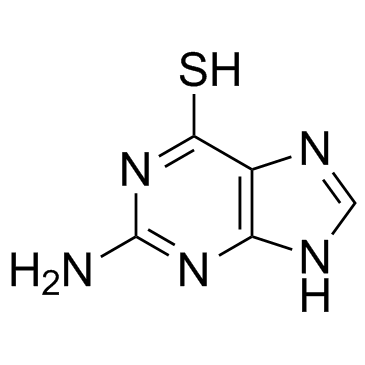6-Thioguanine

6-Thioguanine structure
|
Common Name | 6-Thioguanine | ||
|---|---|---|---|---|
| CAS Number | 154-42-7 | Molecular Weight | 167.192 | |
| Density | 2.1±0.1 g/cm3 | Boiling Point | 460.7±37.0 °C at 760 mmHg | |
| Molecular Formula | C5H5N5S | Melting Point | ≥300 °C(lit.) | |
| MSDS | Chinese USA | Flash Point | 232.4±26.5 °C | |
| Symbol |

GHS06 |
Signal Word | Danger | |
|
Cheminformatics analysis of assertions mined from literature that describe drug-induced liver injury in different species.
Chem. Res. Toxicol. 23 , 171-83, (2010) Drug-induced liver injury is one of the main causes of drug attrition. The ability to predict the liver effects of drug candidates from their chemical structures is critical to help guide experimental drug discovery projects toward safer medicines. In this st... |
|
|
Translating clinical findings into knowledge in drug safety evaluation--drug induced liver injury prediction system (DILIps).
J. Sci. Ind. Res. 65(10) , 808, (2006) Drug-induced liver injury (DILI) is a significant concern in drug development due to the poor concordance between preclinical and clinical findings of liver toxicity. We hypothesized that the DILI types (hepatotoxic side effects) seen in the clinic can be tra... |
|
|
Developing structure-activity relationships for the prediction of hepatotoxicity.
Chem. Res. Toxicol. 23 , 1215-22, (2010) Drug-induced liver injury is a major issue of concern and has led to the withdrawal of a significant number of marketed drugs. An understanding of structure-activity relationships (SARs) of chemicals can make a significant contribution to the identification o... |
|
|
A predictive ligand-based Bayesian model for human drug-induced liver injury.
Drug Metab. Dispos. 38 , 2302-8, (2010) Drug-induced liver injury (DILI) is one of the most important reasons for drug development failure at both preapproval and postapproval stages. There has been increased interest in developing predictive in vivo, in vitro, and in silico models to identify comp... |
|
|
Genetic screens in human cells using the CRISPR-Cas9 system.
Science 343(6166) , 80-4, (2014) The bacterial clustered regularly interspaced short palindromic repeats (CRISPR)-Cas9 system for genome editing has greatly expanded the toolbox for mammalian genetics, enabling the rapid generation of isogenic cell lines and mice with modified alleles. Here,... |
|
|
Quantitative structure-activity relationship and complex network approach to monoamine oxidase A and B inhibitors.
J. Med. Chem. 51 , 6740-51, (2008) The work provides a new model for the prediction of the MAO-A and -B inhibitor activity by the use of combined complex networks and QSAR methodologies. On the basis of the obtained model, we prepared and assayed 33 coumarin derivatives, and the theoretical pr... |
|
|
Fludarabine downregulates indoleamine 2,3-dioxygenase in tumors via a proteasome-mediated degradation mechanism.
PLoS ONE 9(6) , e99211, (2014) Indoleamine 2,3-dioxygenase (IDO) is found in multiple malignancies and exerts immunosuppressive effects that are central in protecting tumors from host T lymphocyte rejection. IDO is an enzyme involved in the catabolism of tryptophan resulting in inhibition ... |
|
|
FDA-approved drug labeling for the study of drug-induced liver injury.
Drug Discov. Today 16 , 697-703, (2011) Drug-induced liver injury (DILI) is a leading cause of drugs failing during clinical trials and being withdrawn from the market. Comparative analysis of drugs based on their DILI potential is an effective approach to discover key DILI mechanisms and risk fact... |
|
|
Loss of TBL1XR1 disrupts glucocorticoid receptor recruitment to chromatin and results in glucocorticoid resistance in a B-lymphoblastic leukemia model.
J. Biol. Chem. 289(30) , 20502-15, (2014) Although great advances have been made in the treatment of pediatric acute lymphoblastic leukemia, up to one of five patients will relapse, and their prognosis thereafter is dismal. We have previously identified recurrent deletions in TBL1XR1, which encodes f... |
|
|
Efficacy of drugs used in the treatment of IBD and combinations thereof in acute DSS-induced colitis in mice.
Life Sci. 92(12) , 708-18, (2013) Although acute dextran sodium sulphate (DSS)-induced colitis in mice is frequently used as a preclinical model for testing drugs involved in inflammatory bowel disease (IBD), only limited data is available that compares the efficacy of established drug treatm... |